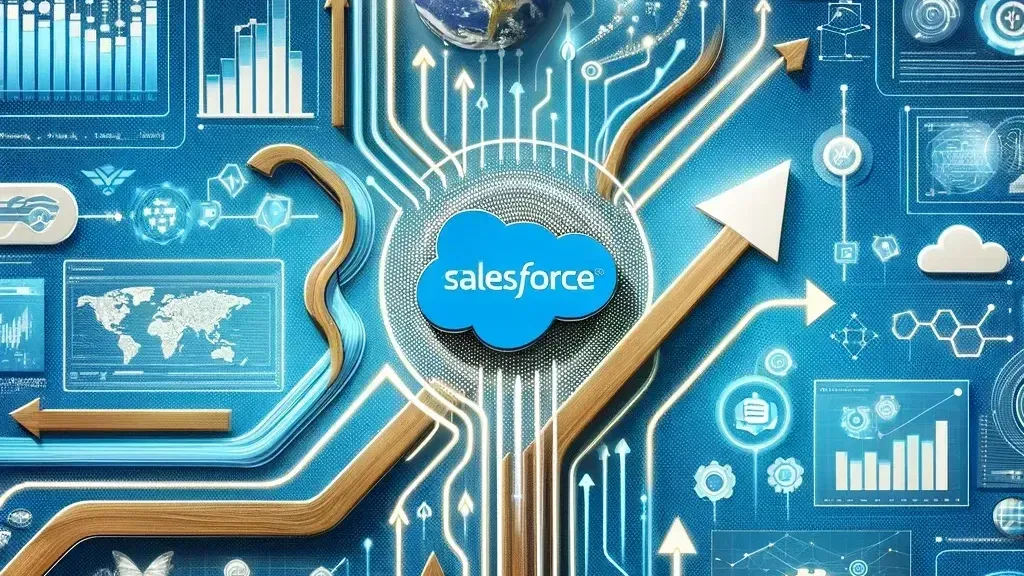Salesforce is essential for capturing valuable customer and operational data, crucial for smart decision-making in today’s competitive business environment. While standard reports provide basic summaries and insights, truly understanding the complex dynamics behind trends and identifying new opportunities requires more advanced analytics. This is where standard tools often fall short.
Tableau steps in to fill this gap, offering a powerful way to explore and understand Salesforce data beyond the basics. With Tableau, you can quickly see how sales are doing across different regions, find out which products are boosting your profits, or identify where customers are dropping off. This goes beyond creating simple charts; it’s about turning your data into actionable insights that can influence strategic decisions and drive business growth.
Tableau and it’s Journey to Prominence
Tableau’s journey from a startup to a prominent player in the data visualization and business intelligence industry is a testament to its innovative approach and commitment to making data understandable to everyone.
Here’s a brief history of Tableau:
Founding and Early Years
2003: Tableau was founded by Chris Stolte, Christian Chabot, and Pat Hanrahan. The foundation of Tableau was laid at Stanford University, where Stolte was working on a PhD project under the guidance of Hanrahan, a professor. Their project focused on visualization techniques for exploring and analyzing relational databases, which led to the development of VizQL (Visual Query Language), the core technology behind Tableau’s products.
2004: Tableau launched its first product, Tableau Desktop, which allowed users to create interactive data visualizations without any programming skills.
Growth and Expansion Era
2006–2010: Tableau introduced Tableau Server, enabling organizations to share and collaborate on data visualizations and reports online. This marked a period of significant growth for Tableau, as it expanded its product line and started to gain traction among businesses looking for user-friendly data analysis tools.
2013: Tableau went public with an IPO on the New York Stock Exchange under the ticker symbol “DATA.” The IPO was a success, reflecting the market’s confidence in Tableau’s potential and its role in the expanding data visualization market.
Innovation Drives Industry Recognition
Tableau has continued to innovate, adding new features and capabilities to its platform, including data preparation tools, mobile access, and advancements in artificial intelligence and machine learning through integrations and enhancements. Its commitment to making data analysis accessible and engaging has contributed to its widespread adoption across many industries.
Growth through Strategic Partnerships and Acqisitions
Tableau has continued to expanded its capabilities and market reach through a methodalgy of strategic acquisitions and partnerships. Notable acquisitions include HyPer, a high-performance database system, and ClearGraph, a startup specializing in natural language query technology, this has allowed Tableau to continue innovating and enhancing there analytics capabilities.
Acquisition by Salesforce
2019: In a move that marked a significant milestone in Tableau’s history, Salesforce acquired Tableau for approximately $15.7 billion. This acquisition integrated Tableau’s advanced analytics capabilities with Salesforce’s leading CRM platform, aiming to create the most powerful analytics platform for businesses.
Salesforce Empowered Growth and Development
Under the Salesforce umbrella, Tableau has continued to grow and evolve, expanding its reach and deepening its capabilities in data visualization and business intelligence. It remains a key player in the industry, known for its powerful, user-friendly analytics platform that serves millions of users worldwide.
Technical Advantages for the Salesforce Ecosystem
Tableau’s acquisition by Salesforce has bolstered its reputation as a leading analytics platform for enterprise data. Its native integration with Salesforce’s enterprise-class CRM software directly enhances the value of your existing Salesforce investment. Let’s explore how these two products combine to create a powerful analytics duo.
- Intuitive Use of Salesforce Data: Seamless connection to Salesforce objects (custom and standard) lets you visualize the data without complex workarounds. If you understand how your Salesforce is structured, Tableau will mirror that for easy analysis.
- Respecting Your Rules: No worries about unauthorized data exposure. Tableau can inherit the roles, permissions, and visibility control you’ve defined within Salesforce. This simplifies user setup and eliminates the risk of accidental data disclosure as your visual dashboards gain broader audiences.
- Beyond Salesforce Silos: Tableau goes beyond just what lives within Salesforce. Imagine enriching your analytics by connecting to external marketing data, e-commerce website behavior, or demographic datasets directly mapped to territories. Suddenly, you gain that ‘full picture’ to identify unseen drivers.
- Data Handling: Tableau Prep empowers those familiar with visual manipulation tools to curate and reshape data for even stronger visualizations. Tableau partners well within your overall system to give you the perfect output to visualize, explore, and act upon.
Supercharge Your Salesforce Data
Tableau seamlessly complements the strengths of Salesforce, elevating its capabilities beyond those offered by its native reports. This flexible visual analytics platform is designed to unlock deeper insights from Salesforce data, enabling intuitive exploration through:
- Powerful Visualizations: Create visually captivating charts, graphs, maps, and more, transforming data from cryptic tables into easily interpretable representations.
- User-Driven Discovery: Intuitive filters, drill-downs, and dynamic dashboards encourage iterative analysis, enabling users to self-serve and find unique answers within their data.
Shareable Insights: Communicate patterns and actionable findings through visually engaging dashboards. These become collaborative tools fostering data-driven decision-making across teams.
Tableau Use Cases: From Insight to Action
Tableau brings compelling solutions for scenarios where standard Salesforce reporting feels limiting. Here’s how it unlocks strategic decisions based on deeper, visual insights:
Case Study 1: Mastering Order Analytics
- Problem: While Salesforce Order Management serves as the system of record, analyzing intricate patterns across sales figures, product performance, and fulfillment cycles often demands tools beyond what Salesforce native reports can provide.
- Tableau Solution: Visualizations reveal critical insights such as: Product mix driving sales (or losses) by region to fine-tune inventory and sales strategy. Revenue distribution across territories to pinpoint growth or underperforming markets. Performance bottlenecks within fulfillment workflows, with visual data on average open days.
- Impact: Data-driven decision-making becomes accessible to key stakeholders. Armed with timely insights, teams react proactively to changing trends and can make strategic choices.
Case Study 2: Optimizing the e-Commerce Experience
- Problem: e-Commerce platforms like Salesforce Commerce Cloud generate a wealth of data on customer behavior. But uncovering patterns that directly impact conversions and revenue can be complex with tabular analyses.
- Tableau Solution: Powerful visualizations can: Map customer journeys from the acquisition source to the checkout (or point of abandonment) to pinpoint optimization opportunities. Spotlight top-performing products and categories by visually associating with revenue trends for tailored promotions or merchandising decisions. Connect shopping cart abandonment patterns with demographic or other data for personalization in retargeting and re-engagement efforts.
- Impact: Tableau turns vast e-commerce data into actionable intel. Optimized marketing campaigns, improved product visibility, and frictionless checkout processes elevate the online shopping experience and propel sales growth.
Deployment & Governance Considerations
Successfully integrating Tableau into your Salesforce ecosystem requires a strategic approach with many things to consider:
Tableau Architecture
- Cloud vs. On-Premise: Evaluate Tableau Online for seamless SaaS integration or choose Tableau Server for granular control (if hosted within your IT infrastructure). Considerations include user volume, security requirements, and existing system architecture.
- Scaling: Anticipate data growth and user adoption. Plan for data extract schedules, server resources, and licensing accordingly for performance and accessibility.
- Align with Salesforce: Adhere to user roles and permissions established in Salesforce. Tableau’s robust security model facilitates seamless integration and prevents unauthorized data access.
- Data Sensitivity: Consider creating curated data extracts tailored to specific business needs to manage data exposure. Row-level security can refine what each user group sees within a dataset.
Data Freshness & Management
- Refresh Strategies: Balance near real-time updates against system load. Explore incremental data refreshes and efficient extract processes provided by Tableau to handle large datasets.
- Version Control: Implement structured approaches for versioning Tableau workbooks and datasets, particularly within complex analytic scenarios.
Change Management & Training
- Rollout Approach: Consider pilot programs, targeted training, and open communication across business and technical teams to minimize adoption disruption.
- Continuous Education: Provide ongoing resources such as tutorials, documentation, and internal communities to promote continuous skill development on the Tableau platform.
Final Considerations & Next Steps
Harnessing the power of Tableau elevates your Salesforce data strategy. Integrating these analytics capabilities is an empowering step for businesses looking to utilize data-driven insights throughout their organizations. To take that first step and continue to expand your knowledge on this cutting edge product:
Hands-On Exploration:
- Tableau Trial: Dive in with a free trial to experiment with Tableau’s interface, connect to Salesforce data, and build dashboards relevant to your use cases.
- Technical Resources: Delve into developer resources through Trailhead modules, the Tableau API knowledge base, and the Salesforce Developers portal.
- Targeted Solutions: Start with a well-defined business problem where Tableau has a transformative potential (refer back to our case studies for ideas). Project success includes creating compelling visual analytics and engaging key stakeholders throughout the process.
- Cross-Team Approach: Involve business leaders, and data analyst’s alongside technical professionals and creare shared ownership of new approaches to analytics. Early, positive results build support for the platform expansion.
Continuous Learning
- Feature Updates: Stay informed about evolving Tableau capabilities and how the Salesforce partnership influences enhancements like new connections or functionalities.
- Data-Driven Leadership: Demonstrate how insightful, visual analytics influence strategic choices. Architects embracing this philosophy lead the development of a more empowered and data-informed organization.
Embracing Tableau can unlock the potential of your Salesforce data, and empower users at all levels to unlock, and enables actionable, business-driving insights.




